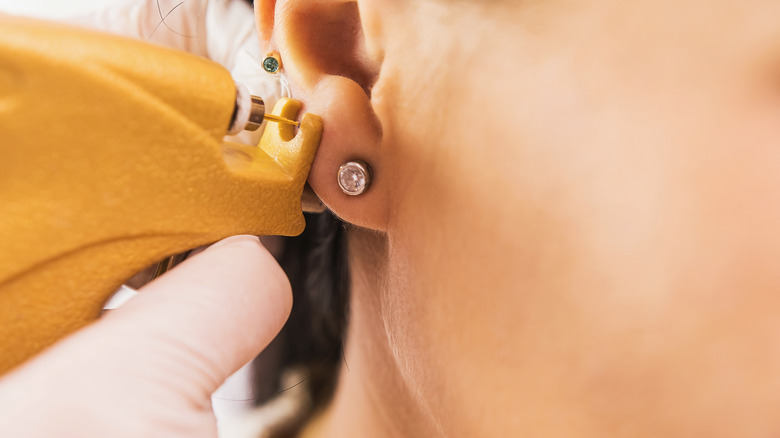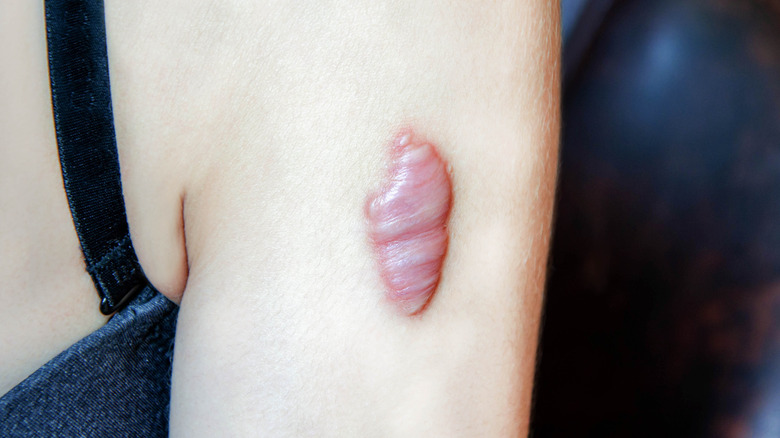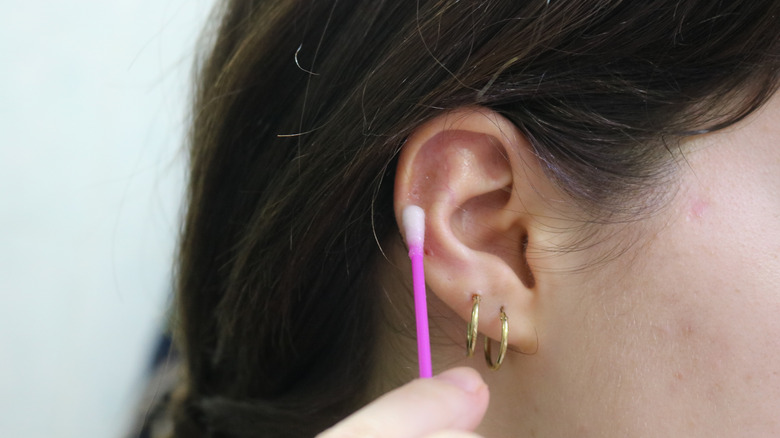Keloids: What They Are And How They Differ From Piercing Bumps
So you want to get a piercing? So do half the country. Statista notes that more than half of Americans have their earlobes pierced, and about 14 percent have piercings on other body parts. This statistic isn't really all that surprising, considering how piercings also function as a medium for self-expression. It's fun to let your personality and creativity shine through various piercing placements and assortments of gems and jewelry.
Just as how some people are fixated on getting tattoos, piercings are apparently addicting, too, but not in a self-destructive way. "After conquering the anxiety of successfully receiving and healing that first body piercing, it becomes more exciting to choose the next one," Stephanie Hutter-Thomas, a professional body piercer, shared with Refinery29, adding that you get "desensitized" to it the more piercings you have. "From my perspective, it becomes more a matter of pursuing or maintaining a sense of personal identity, rather than a pathology like addiction."
With this in mind, there's still no discounting the fact that piercings are a form of body modification, so there are risks associated with getting them aside from pain. After getting a new piercing, even with thorough aftercare, you may still get a piercing bump, which is your body's way of reacting to inflammation, per Medical News Today. This may be a cause of concern for you if you're getting it for the first time, and you may even mistake it for a keloid, but it's important to note that there's a difference between the two, with the latter being much more serious.
How to distinguish a piercing bump from a keloid
Piercing bumps and keloids are starkly different in more ways than one. Dr. Anar Mikailov, a board-certified dermatologist, told Bustle that piercing bumps are reminiscent of pimples and are characterized by "soft, slightly mobile bumps under the skin that is typically the size of a small pea." They also usually appear directly on the piercing site and go away on their own — as long as you clean properly, of course.
Meanwhile, keloids are much more noticeable because, in a nutshell, they're a much more intense form of hyperpigmentation. They are scars with a more prominent protrusion, but if you want a more technical explanation, professional piercer Johnny Pearce noted that keloids are "defined as an uncontrolled overgrowth of scar tissue consisting of different types of collagen." He told PopSugar that they arise from "any type of wound or injury," regardless of where they are in your body. Plus, they're exceptionally larger than bumps and vary in color and texture. Oh, and they're not a threat to your overall health.
The bad news? Unlike piercing bumps, keloids are quite impossible to get rid of, unless you resort to extensive treatment. They are not the type of scars that succumb to DIY alternatives, nor do they disappear on their own. You would have to consult your dermatologist for the best course of treatment, and depending on the severity of your keloid, you may be prescribed steroids and injections, or be asked to undergo laser removal or even surgery.
Can a piercing bump turn into a keloid?
Not all keloids come from piercing bumps but all piercing bumps can potentially turn into keloids. What's more, your susceptibility to keloids hinges on a variety of factors, with Very Well Health noting that your likelihood of getting them is enhanced if you have a darker complexion or relatives that have them.
If you're worried about a piercing bump evolving into a keloid, dermatologist Dr. Alok Vij of Cleveland Clinic explained that piercing-induced keloids are normally associated with ear piercings (specifically the cartilage area) and very rarely develop on piercings on other body parts. If you so much as suspect that your piercing bump is turning into a keloid, swift action is necessary. "Keloids can be extraordinarily difficult to treat," he said, adding that you should consult a doctor as soon as you can. "If they're left on their own and continue to grow, they can become disfiguring, and the treatments can become quite aggressive in order to be effective."
If you insist on getting new piercings anyway despite having an increased predisposition to keloids, dermatologist Dr. Jennifer L. MacGregor doubled down on seeking professional advice right away. Otherwise, you'll just let the keloid take a life of its own. "At the first sign of thickening, firm bumps, redness, tender or raised areas within a scar — see a dermatologist or your surgeon. Do not delay treatment," she told Byrdie. "Do not initiate treatment and fail to follow up (every six to eight weeks) to keep the scar as soft and flat as possible."


